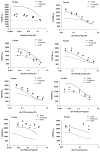Modeling and predicting competitive sorption of organic compounds in soil
- PMID: 21061392
- PMCID: PMC3040038
- DOI: 10.1002/etc.343
Modeling and predicting competitive sorption of organic compounds in soil
Abstract
Binary systems consisting of 1,2-dichlorobenzene (12DCB) + competitor were investigated over a range of concentrations of competitor in three natural sorbents with distinct characteristics. Two models, the ideal adsorbed solution theory (IAST) and the potential theory (Polanyi-based multisolute model), widely used in the prediction of multisolute sorption equilibrium from single-solute data, were used to simulate competitive sorption in our systems. The goal was to determine which multisolute model best represented the experimentally obtained multisolute data in natural sorbents of varied properties. Results suggested that for the sorbents and sorbates studied, the IAST model provided much better results. On average, the IAST model provided lower errors (23%) than the potential model (45%). The effect of competitor structure on the degree of competition was also investigated to identify any relationships between competition and structure using molecular descriptors. The competitors chlorobenzene, naphthalene, 1,4-dichlorobenzene, 1,2,4-trichlorobenzene all showed very similar degrees of competition, while benzene, phenanthrene, and pyrene were the least effective competitors toward 12DCB across all sorbents. Different sorption sites or sorption mechanisms might be involved in the sorption of these molecules leading to a lack of competitive behavior. A significant relationship between competitor structure and the degree of competition was observed at environmentally relevant sorbed competitor concentrations for the soil containing the highest fraction of hard carbon (Forbes soil).
© 2010 SETAC.
Figures


Similar articles
-
Effects of competitor and natural organic matter characteristics on the equilibrium sorption of 1,2-dichlorobenzene in soil and shale.Environ Sci Technol. 2004 Nov 15;38(22):5863-70. doi: 10.1021/es049668u. Environ Sci Technol. 2004. PMID: 15573583
-
The equilibria of bisolute sorption on soil.Chemosphere. 2011 May;83(7):1005-13. doi: 10.1016/j.chemosphere.2011.02.009. Epub 2011 Mar 4. Chemosphere. 2011. PMID: 21377187
-
Modeling sorption of neutral organic compound mixtures to simulated aquifer sorbents with pseudocompounds.J Environ Qual. 2013 May-Jun;42(3):852-60. doi: 10.2134/jeq2013.01.0025. J Environ Qual. 2013. PMID: 23673953
-
Sorption of hydrophobic organic compounds on natural sorbents and organoclays from aqueous and non-aqueous solutions: a mini-review.Int J Environ Res Public Health. 2014 May 9;11(5):5020-48. doi: 10.3390/ijerph110505020. Int J Environ Res Public Health. 2014. PMID: 24821385 Free PMC article. Review.
-
Relative role of aliphatic and aromatic moieties as sorption domains for organic compounds: a review.Environ Sci Technol. 2009 Mar 15;43(6):1680-8. doi: 10.1021/es803149u. Environ Sci Technol. 2009. PMID: 19368157 Review.
Cited by
-
Sorption of selected pharmaceuticals by a river sediment: role and mechanisms of sediment or Aldrich humic substances.Environ Sci Pollut Res Int. 2018 May;25(15):14532-14543. doi: 10.1007/s11356-018-1684-0. Epub 2018 Mar 11. Environ Sci Pollut Res Int. 2018. PMID: 29527647
References
-
- McGinley PM, Katz LE, Weber WJ. A distributed reactivity model for sorption by soils and sediments. 2. Multicomponent systems and competitive effects. Environmental Science & Technology. 1993;27:1524–1531.
-
- McGinley PM, Katz LE, Weber WJ. Competitive sorption and displacement of hydrophobic organic contaminants in saturated subsurface soil systems. Water Resour Res. 1996;32:3571–3577.
-
- Li J, Werth CJ. Evaluating competitive sorption mechanisms of volatile organic compounds in soils and sediments using polymers and zeolites. Environmental Science & Technology. 2001;35:568–574. - PubMed
-
- Xing BS, Pignatello JJ, Gigliotti B. Competitive sorption between atrazine and other organic compounds in soils and model sorbents. Environmental Science & Technology. 1996;30:2432–2440.
-
- White JC, Pignatello JJ. Influence of bisolute competition on the desorption kinetics of polycyclic aromatic hydrocarbons in soil. Environmental Science & Technology. 1999;33:4292–4298.
Publication types
MeSH terms
Substances
Grants and funding
LinkOut - more resources
Full Text Sources

